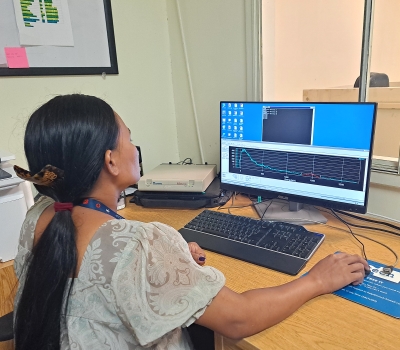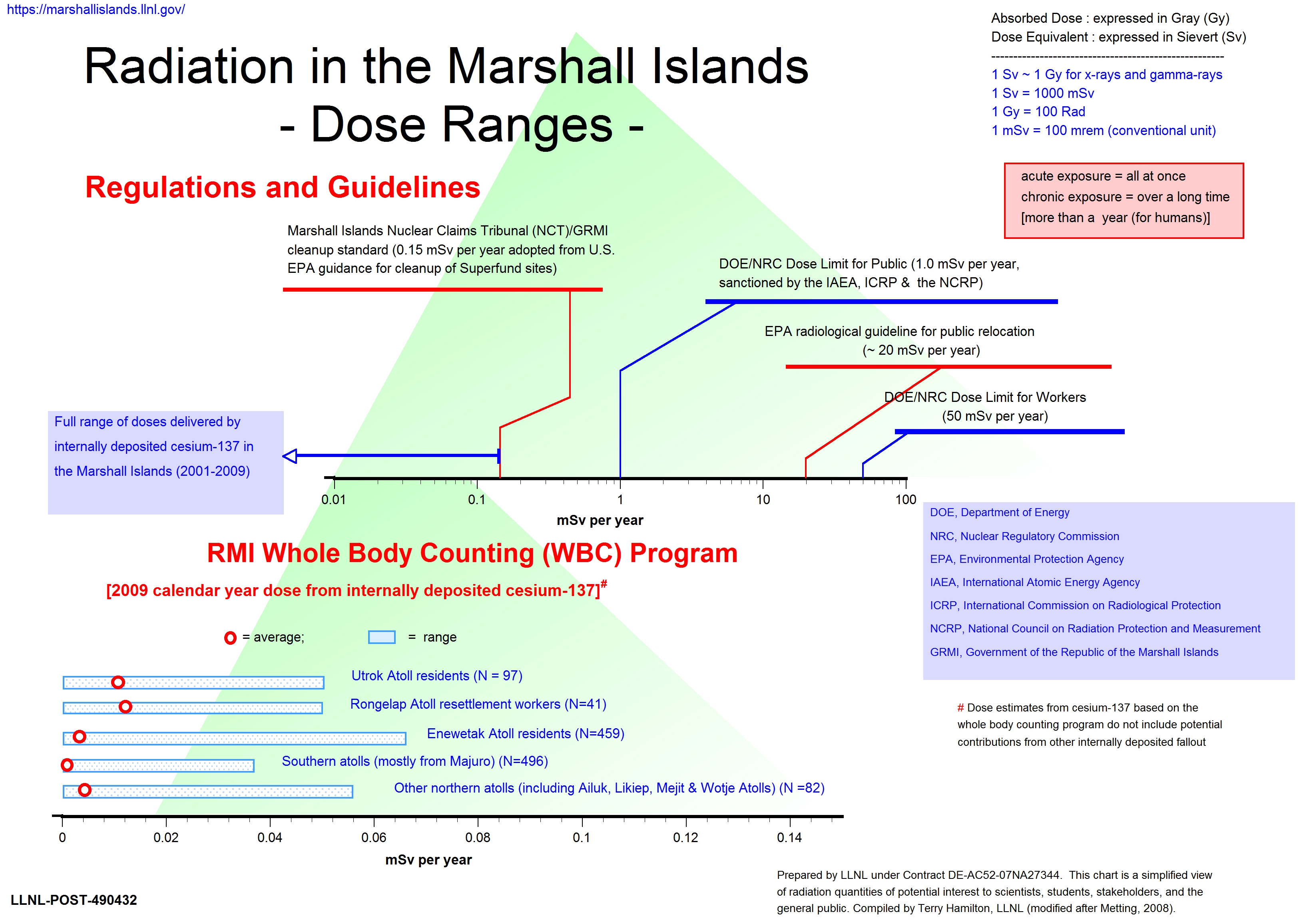Whole Body Counting
WHAT IS A WHOLE-BODY COUNTER?
A whole-body counter is an instrument that measures gamma rays coming from radioactive decay of radionuclides deposited inside the human body. Whole-body counters are very sensitive devices. Gamma-rays that escape the human body with sufficient energy interact with the detector system. Common types of radiation detectors include inorganic scintillator crystals, such as a Sodium Iodide (NaI) detector, and semi-conductor detectors. The incident radiation on the detector generates a signal that can be transposed into a gamma-ray spectrum of different energies and intensities and used to identity and quantity radionuclides contained in the body.
WHY DO WHOLE BODY COUNTING IN THE MARSHALL ISLANDS?
The key residual fallout radionuclides of radiological concern in the Marshall Islands include
- Fission products such as
- Cesium-137 (137Cs)
- Strontium-90 (90Sr)
- Long-lived alpha emitting radionuclides such as
- Plutonium-239 (239Pu)
- Plutonium-240 (240Pu)
- Plutonium-238 (238Pu)
- Americium-241 (241Am)
Coral soils in the Marshall Islands contain low concentrations of aluminosilicates (clay materials) that can potentially bind up available soil cesium-137 and reduce its uptake in plant foods such a coconut. Similarly, coral soils are deficient in Potassium (K), an essential nutrient for plant growth. Cesium (Cs) is an alkali metal and has chemical and physical properties like potassium. Locally grown plants in the Marshall Islands attempt to satisfy their nutritional requirements, by making up for a lack of available potassium by taking up soil cesium as a surrogate element, including any radiocesium (cesium-137). Consequently, soil-to-plant transfer ratios of cesium-137 from coral soils are generally much higher than those observed for most other soil types around the world.
Therefore, in general, people living in the Marshall Islands are more at risk from radiation exposure from dietary intakes of cesium-137 contained in locally grown foods, especially for those individuals living in the northern Marshall Islands where levels of fallout contamination are highest.
Whole body counting provides a direct and accurate measure of the amount of cesium-137 inside the body of people independent of any dietary assumptions. The biokinetic behavior of cesium-137 inside the human body is also well known. This allows for whole-body count measurements of internally deposited cesium-137 to estimate intake and be converted to a radiation dose. The radiation dose is used to quantify potential health risks associated with radiation exposure.
Additionally, measurements of internally deposited cesium-137 based on whole-body counting along with environmental measurements of the strontium-90/cesium-137 activity ratios in foods provides a reasonable estimate of the ingestion dose and potential risks from strontium-90.
It should be noted, the most common radionuclide found in the human body is potassium-40 (40K). Potassium-40 is a naturally occurring radioisotope of potassium and is readily detected during whole-body count measurements of people.
HOW IS WHOLE BODY COUNTING DONE IN THE MARSHALL ISLANDS?
Three whole body counting facilities have been developed in the Marshall Islands. These facilities are located on Enewetak, Majuro, and Rongelap Atolls. Wherever possible, the whole-body counting program is conducted using the same quality requirements as established under the U.S. Department of Energy Laboratory Accreditation Program (DOELAP) for internal dosimetry. System background and other quality control check counts are performed daily to ensure that the measurement system conforms to all applicable quality requirements.
Trained Marshallese technicians are responsible for daily operation of the facility including responsibilities for scheduling of personal counts, performing system performance checks, database recording, and initial reporting of results. Scientists from the Lawrence Livermore National Laboratory (LLNL) provide training and ongoing technical and scientific support services. LLNL program scientists also conduct a more thorough appraisal of data quality prior to releasing data and information to this website.
The Marshall Islands Whole-Body Counting Program was developed in cooperation with local and national government officials and forms a programmatic strategic initiative to provide capacity building and self-help measures to address long-term radiological protection monitoring and surveillance needs in the Marshall Islands.
FIND YOUR INDIVIDUAL DOSE REPORT View Report
WHOLE-BODY COUNTING, A NON-INVASIVE TEST
Whole-body counting is a non-invasive test that takes about 15-minutes to perform. Most program volunteers are encouraged to repeat the process at least annually. The whole-body counting program is providing an unprecedented level of radiation protection monitoring for the people of the Marshall Islands and is expected to continue until all parties agree that radiation protection measures can be relaxed. The existing whole-body counting database contains over 10,000 registered volunteers or about 15 percent of the Marshall Islands population. These measures do not include many thousands of whole-body counts performed by the Brookhaven National Laboratory (BNL) prior to the program moving to LLNL during the late 1990s.
WHAT DOES WHOLE-BODY COUNTING DATA TELL US?
In combination with environmental monitoring data, residents who receive a whole-body count showing the presence of cesium-137 can now make an informed decision about their eating habits or lifestyle choices based on what is considered a ‘safe’ or acceptable health risk.
The Republic of the Marshall Islands Nuclear Claims Tribunal adopted a cleanup standard of radioactively contaminated sites of 0.15 milliSievert (mSv)# per year (EDE, or Effective Dose Equivalent) using a lifetime cancer risk criterion recommended by the U.S. Environmental Protection Agency (EPA). Other national and international agencies, including the U.S. Department of Energy (DOE), the U.S. Nuclear Regulatory Commission (NRC), the International Atomic Energy Agency (IAEA), the International Commission on Radiological Protection (ICRP), and the National Council on Radiation Protection have adopted a less conversative standard of 1 mSv per year for radiation protection of the public.
As displaced communities return to their ancestral homelands, the Marshall Islands Whole-Body Counting Program will allow the U.S Department of Energy to monitor resettled populations and provide assurances that radiation related health risks remain at or below these established standards. The whole-body counting program will also provide an accurate basis to assess and track individual high-end doses, seasonal fluctuations in dietary uptake of cesium-137, and future changes in exposure conditions associated with land-use, dietary habits, and/or remedial actions.







